Orazio Gentileschi | |
|---|---|
.jpg.webp) Portrait of Orazio Gentileschi (c. 1630) by Lucas Emil Vorsterman, for "The Iconography" | |
| Born | Orazio Lomi Gentileschi 9 July 1563 (baptized) |
| Died | 7 February 1639 |
| Nationality | Italian |
| Known for | Painting |
| Movement | Mannerism |
Orazio Lomi Gentileschi (1563–1639) was an Italian painter. Born in Tuscany, he began his career in Rome, painting in a Mannerist style, much of his work consisting of painting the figures within the decorative schemes of other artists.
After 1600, he came under the influence of the more naturalistic style of Caravaggio. He received important commissions in Fabriano and Genoa before moving to Paris to the court of Marie de Medici. He spent the last part of his life at the court of Charles I of England and died in London. He was the father of the painter Artemisia Gentileschi.
Life
Gentileschi was born in Tuscany, the son of a Florentine goldsmith called Giovanni Battista Lomi, and baptised at Pisa on 9 July 1563. He later took the name Gentileschi from an uncle with whom he lived after moving to Rome [1]: p.6 in either 1576 or 1578.[2]
Early years in Rome
Much of Gentileschi's early work in Rome was collaborative in nature.[2] He painted the figures for Agostino Tassi's landscapes in the Palazzo Rospigliosi, and possibly in the great hall of the Quirinal Palace, although some authorities ascribe the figures there to Giovanni Lanfranco.[3] He also worked in the churches of Santa Maria Maggiore, San Nicola in Carcere, Santa Maria della Pace and San Giovanni in Laterano.
Influence of Caravaggio
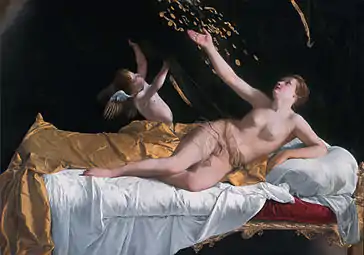
From around 1600, Gentileschi's style was transformed by his contact with Caravaggio[1]: p.8 – several years his junior – who was then in Rome. In late August 1603, Giovanni Baglione filed a suit for libel against Caravaggio, Gentileschi, Ottavio Leoni, and Filipo Trisegni in connection with some unflattering poems circulated amongst the artistic community of Rome over the preceding summer. Caravaggio's testimony during the trial as recorded in court documents is one of the few insights into his thoughts about the subject of art and his contemporaries.[4] After Caravaggio's flight from Rome, Gentileschi developed a more personal Tuscan lyricism, characterized by lighter colours and precision in detail, reminiscent of his Mannerist beginnings.
In 1611, Gentileschi collaborated with Tassi again, on works including the decorations of the Casino delle Muse. However, their association ended due to a dispute over money.[2] In 1612 he was again called to the Tribunal of Rome, this time to speak against Tassi, who was charged with the rape of his daughter Artemisia Gentileschi.
Details of Gentileschi's studio practice during this period have been preserved in the records of Tassi's trial. Following Caravaggio's lead, he often painted directly from models.[1]: p.10 One of the witnesses at the trial, Giovanni Molli, a 73-year-old pilgrim from Palermo, said that he had posed for several pictures around 1610–11, including a full length St Jerome.[1]: p.94 Gentileschi also made studies from life for later use: he seems to have based the head of Abraham in the Sacrifice of Isaac, painted in the early 1620s, on studies of Molli's head made more than ten years before.[1]: p.6
.jpg.webp)
Between around 1613 and 1619 he did much of his work for patrons in the Roman Marches, in the cities of Ancona and Fabriano.
Genoa
In 1621, Gentileschi moved to Genoa, at the invitation of Giovanni Antonio Sauli, who had previously commissioned works from his brother, Aurelio Lomi. Gentileschi's works for Sauli included a Magdalene, a Danäe and Lot and his Daughters. He found other patrons in the city, including Marcantonio Doria, for whom he carried out an elaborate scheme of frescoes of Old Testament subjects in a "casino" (since destroyed) in the grounds of his palace at Sampierdarena.[1]: p.167
France and England
In the summer or autumn of 1624, Gentileschi left Genoa for Paris, and the court of the Queen Mother, Marie de Medici. He stayed for two years, but only one picture from his time there has been identified, an allegorical figure of Public Felicity, painted for the Palais du Luxembourg, and now in the collection of the Louvre.[1]: p.203
In 1626, Gentileschi, accompanied by his three sons,[1]: p.226 left France for England, where he became part of the household of the King's first minister, George Villiers, 1st Duke of Buckingham.[1]: p.224 He was to remain in England for the rest of his life. One of his first major works there was a large ceiling painting (since destroyed) of Apollo and the Muses for Buckingham's newly rebuilt London home, York House, in the Strand.[1]: p.225 He had already received a certain degree of royal patronage by the time of Buckingham's murder in April 1628, and all his commissions after this event came from the royal family.[1]: p.223
He was a favourite artist of Queen Henrietta Maria, for whom he carried out the ceiling paintings at Queen's House, Greenwich (later transferred to Marlborough House, London).[1]: p.228 The paintings of his English period are more elegant, artificial and restrained than his previous works. They include two versions of The Finding of Moses, (1633) one of which was sent to Philip IV of Spain; previously assumed to have been a gift from Charles I, it is now known to have been sent on Gentileschi's own initiative.[5]
In England van Dyck made a drawing of Gentileschi for inclusion in his Iconographia, a series of portraits of the leading artists, statesmen, collectors and scholars of the time, which he intended to publish as a set of engravings.[6]
Gentileschi died in London in 7 February 1639, and was buried in the Queen's Chapel at Somerset House.[1]: p.228
Works
- Orazio Gentileschi
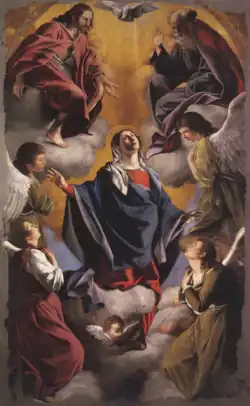
.jpg.webp) David and Goliath
David and Goliath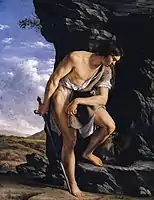 David Contemplating the Head of Goliath
David Contemplating the Head of Goliath Saint Mary Magdalen in Penitence
Saint Mary Magdalen in Penitence Cupid and Psyche
Cupid and Psyche
 Young Woman Playing a Violin
Young Woman Playing a Violin.jpg.webp)
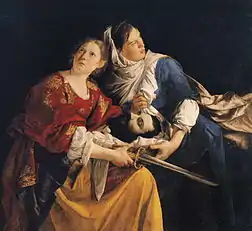 Judith and Her Maidservant with the Head of Holofernes
Judith and Her Maidservant with the Head of Holofernes Portrait of a Young Woman as a Sibyl
Portrait of a Young Woman as a Sibyl_-_Orazio_Gentileschi.jpg.webp)
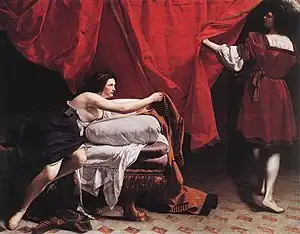
.jpg.webp)
.jpg.webp)
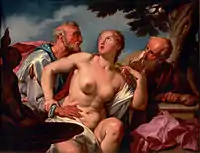 Susanna and the Elders
Susanna and the Elders
References
- 1 2 3 4 5 6 7 8 9 10 11 12 13 Mann, Keith Christiansen ; Judith W. (2001). Orazio and Artemisia Gentileschi : [published in conjunction with the exhibition "Orazio and Artemisia Gentileschi: Father and Daughter Painters in Baroque Italy" held at the Museo del Palazzo di Venezia, Rome, October 15, 2001 - January 6, 2002 : The Metropolitan Museum of Art, New York, February 14 - May 12, 2002 ; The Saint Louis Art Museum, June 15 - September 15, 2002]. New Haven [u.a.]: Yale Univ. Press [u.a.] ISBN 9780300090772.
{{cite book}}: CS1 maint: multiple names: authors list (link) - 1 2 3 The Genius of Rome 1592-1693 2001, p. 378.
- ↑ One or more of the preceding sentences incorporates text from a publication now in the public domain: Chisholm, Hugh, ed. (1911). "Gentileschi, Artemisia and Orazio de' s.v. Orazio". Encyclopædia Britannica. Vol. 11 (11th ed.). Cambridge University Press. p. 602.
- ↑ Catherine Puglisi (1998). Caravaggio. Phaidon. pp. 224–228. ISBN 9780714839660.
- ↑ Sale of the Century 2002, p. 217.
- ↑ "Anthony van Dyck, Orazio Gentileschi, a portrait drawing". British Museum. Archived from the original on 22 August 2012. Retrieved 26 November 2012.
Sources
- Orazio and Artemisia Gentileschi (Exhibition catalogue). New York: Metropolitan Museum of Art. 2002.
- The Genius of Rome 1592-1693 (Exhibition catalogue). London: Royal Academy of Arts. 2001.
- Sale of the Century:Artistic Relations between Spain and Great Britain1604–1655. Yale University Press in Association with Museo Nacional del Prado. 2002.
External links
 Media related to Orazio Gentileschi at Wikimedia Commons
Media related to Orazio Gentileschi at Wikimedia Commons